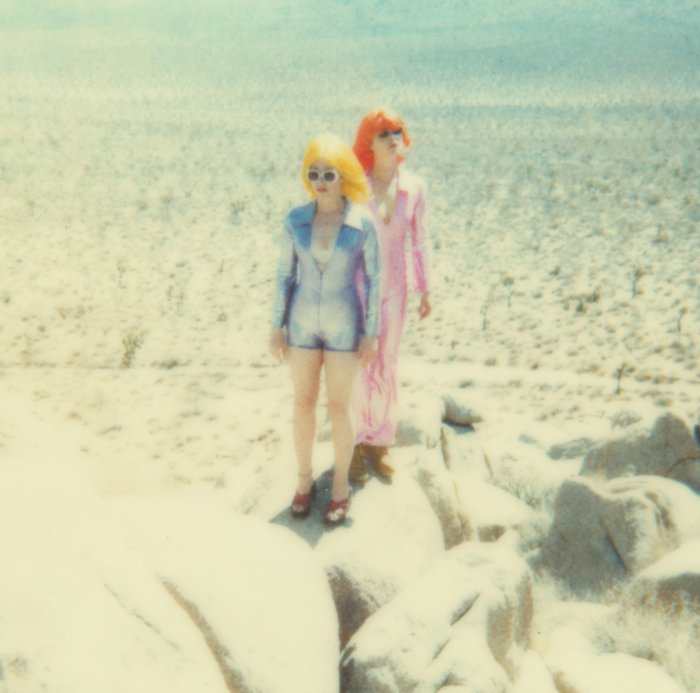
Stefanie Schneider - Malina (Stranger than Paradise)
Nr. 83041703

Nr. 83041703

On the Rocks (Long Way Home) - 1999
featuring Radha Mitchell
58x56cm,
Edition 5/10,
analog C-Print, hand-printed by the artist, based on the original Polaroid.
Certificate and Signature label.
Artist Inventory # 253.05.
Not mounted.
Stefanie Schneider at Alysia Duckler Gallery
Berlin-based artist Stefanie Schneider enlarges expired Polaroid stock into burned-out C-prints. The lossy images almost completely dissolve into lurid color abstractions. The shiny pink of a sex kitten's glittery body suit becomes an electrified, free-floating color field. The vivid, flame-orange hair of a 70's sexploitation film star vibrates against the dusty gray of the sky above an LA desert. Skin tones and facial details in the figures are completely lost. They are refugees from Faster Pussycat Kill Kill, doomed to aimlessly wander in a burned-out celluloid limbo.
Schneider's process is one of reflexive inversion. She stages her scenes and shoots them with expired Polaroid film, producing a decayed positive. The decay keeps the image from being a true positive, creating a hybrid: a positive with negative traits: burned-out light values, super-saturated colors, lost information. The Polaroid is then re-photographed, producing a negative. This negative, one imagines, is more compelling than the finished work. It must be filled with deep, rich darkness and luminous color.
The negative enlarges and duplicates the original Polaroid as a C-print, preserving the decay as an archival photograph. Schneider's process creates a circuit between ideas of preservation and decay. Her work emerges from the loop unsettled. The final C-prints are windows into a fluctuating limbo. They depict actors and environments neither here nor there; neither completely fictional nor completely real, and the information needed to make a decision in this regard is lost; burned away.
The viewer is left sifting through broken artifacts and assembling scraps of imagery. The strength of this work is the opportunity it provides the viewer. Although the decayed images are visually unsatisfying, they are cognitively spacious. The burned-out highlights are also blank areas in which the observer can rebuild lost narratives. Schneider eschews the authoritative power of the art object and instead prolongs the life of damaged, uncertain images.
The figures themselves seem to cling to existence through pure, unabated, fashion-conscious ferocity. Instead of possessing a complex, human identity, they are reduced to flattened neon hyper-vixens baring their teeth and their substantial cleavage in the scathing sun of a SoCal desert. They brandish squirt guns as sexual weaponry and sneer behind gigantic insectoid sunglasses. The stupid brutality of these misguided archetypes of feminine power is eased by the delicacy of their disappearance. They are images of vaguely remembered freaked-out alter egos, the noble heroes of Gloria Steinem's too-much-pizza-and-beer nightmares.
Often, our nightmares are the best remembered. Pleasant dreams mix too easily with sleep. Nightmares are dislocating. We toss and turn and separate our mind into a dreaming part and a part that is strangely aware. Questions generated by a partition of consciousness float through the dream experience itself. "Am I dreaming now?" We hear this even as we are in the midst of performing some alien task within the storyline of the dream, and somehow, we accept the schism.
Schneider operates within this gap. Are these photographs of photographs real photographs? Is Schneider's final product simply an archive of the source Polaroid? Her costumed actors recreate scenes from D-grade 70's sexploitation films. Schneider wraps these unconvincing fictions in yet another layer of fiction, and we are unable to sustain whatever small suspension of disbelief we had engaged watching Faster Pussycat.
This is Schneider's true subject. What happens when fictions evaporate? What traces are left after the disappearance of something whose ties to the real were tenuous to begin with? What do ghosts turn into when they die? Schneider recreates and decays fictions that perhaps weren't worth preserving in the first place, as a negative of a negative.
Cum să cumperi de la Catawiki
1. Descoperă ceva special
2. Plasează cea mai mare ofertă
3. Fă o plată sigură